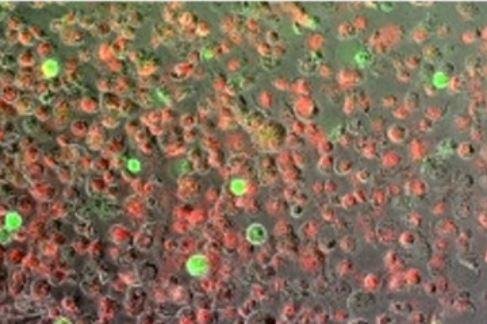Scientists at Binghamton University in New York had more success killing cancer cells in the pancreas through heating and freezing, a process known as dual thermal ablation, rather than heating or freezing alone. In the image, live cells are in green and dead cells are in red. Photo courtesy of Binghamton University
Feb. 26 (UPI) -- Scientists have developed a way to kill more cancerous cells in the pancreas through a heating and freezing process.
The researchers at Binghamton University in New York had success killing the tumors through a process known as dual thermal ablation, according to a study published this month in Liver and Pancreatic Sciences.
Cancer in the pancreas, which is located behind the stomach, starts when cells start to grow out of control.
The American Cancer Society estimates that 1 in 63 individuals will be diagnosed with the cancer in their lifetime, and 44,300 die annually in the United States. About 95 percent of patients diagnosed with pancreatic cancer will die because of limited treatment options, the American Cancer Society estimates.
"How do we solve the problem of pancreatic cancer when it comes to trying to get rid of the tumor, when chemo and radiation just simply doesn't work?" Robert Van Buskirk, a professor of biological sciences and director at Binghamton University's Institute of Biomedical Technology, said in a news release Monday. "The whole idea is, can one come up with a different surgical intervention that's less invasive and more effective?"
They wanted to know whether freezing and heat in combination is more effective than alone. When pancreatic cancer cells are frozen, in cryoablation, a lot of them die, but some will survive and regrow, the researchers said. But if you heat them, they'll also die and come back.
"What we've observed is that we are able to achieve complete cell death using a combination of heating and then freezing at temperatures that alone would not be lethal to kill pancreatic cancer cells," said Kenneth Baumann, a graduate student studying biology.
Researchers used various technologies to determine the level of cell death. They checked regrowth, as well as which cell stress pathways were activated, and were able to determine the specific paths of cell death activated from the dual thermal exposure.
"When cells are disturbed -- which means they are frozen or they see heat -- various cell stress pathways are activated," Van Buskirk said. "The interesting thing about cells, especially cancer cells, is that they will activate pathways to protect themselves. The objective of this line of molecular-based research is to find out which stress pathways are activated in pancreatic cancer cells so that we can better understand why dual-thermal ablation appears to be more effective."
In addition to working to make the treatment method more effective, the researchers are also working on better ways of delivering ablative therapy, including new catheter technologies allowing for better targeting.
"If a very thin catheter can be developed to target the tumor, and if we understand how pancreatic cancer responds to ablation at the molecular level, then we may be able to develop a new therapy to approach something that has been completely unapproachable, the targeted killing of a tumor in a very difficult place: the pancreas," said Van Buskirk.















